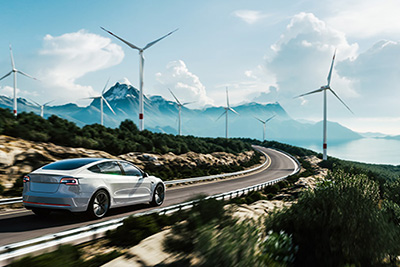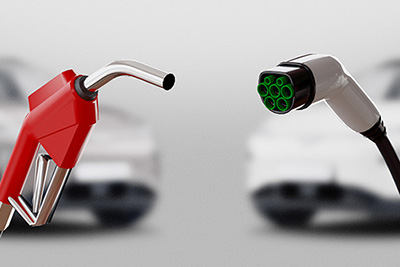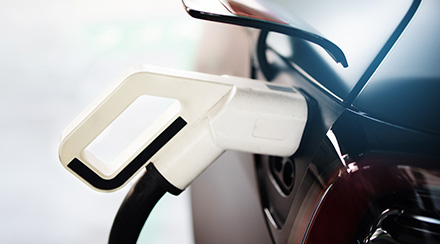How Do Hybrid and All-Electric Cars Work?
Electric vehicles have been in development for decades, and we’re now living in the future that automotive engineers have long envisioned: thousands of affordable, fully electric cars are traversing our roads and recharging their batteries at home, work and public charging stations.
You probably already know that electric cars are better for the environment and can save you money in the long run on fuel and maintenance, but do you know how electric cars work? In many ways, they’re similar to the gas-powered cars you’re used to, but the things that make electric cars different represent some of the most important technological advances of our time.

How Do Electric Cars Work?
Unlike gas-powered vehicles, which draw their power from fuel-burning internal combustion engines, electric vehicles get their power from a large internal battery. This battery is primarily charged by plugging the car into a charging station or electrical outlet, though some models generate additional electricity through features like solar panels and regenerative braking.
The battery itself is a technological feat. It’s similar to the batteries inside our favorite gadgets, but much larger in both size and capacity. Electric car batteries are lithium-ion, which is different from the lead acid batteries you’ll find under the hood of most traditional vehicles. These batteries come in a variety of capacities, and the larger the capacity, the farther the car can travel on a single charge.
In place of the gas-powered internal combustion engine is an electric traction motor that uses electricity from the battery to power sets of electromagnets. Just as you can use refrigerator magnets to invisibly “push” one away from the other, the electromagnets inside an electric car repel each other to turn the drive shaft and the car’s wheels. Other systems like heating, air conditioning, lights and radio are all powered directly from the battery as well.
Even though electric cars are powered by today’s most sophisticated technology, their overall design is much simpler than that of gas-powered cars. Electric cars have fewer parts, and as such, need less maintenance. You’ll never take an electric vehicle in for an oil change, transmission work, belt replacement or spark plugs – but you will need to periodically replace the tires and brakes. Between the lack of routine maintenance needs and the potential cost savings of electricity over gasoline, the average monthly operating cost of owning an electric car is often lower than that of an equivalent gas-powered vehicle.

How Do Hybrid Cars Work?
As the predecessors to fully electric vehicles, hybrid cars work a little differently. These vehicles have everything a fully gas-powered car has – including an internal combustion engine, a gas tank and all those belts, fluids and filters that need routine replacement. But in addition to all that, they also have a large lithium-ion battery and an electric traction motor.
There are two types of hybrid cars: hybrid electric vehicles (HEVs) and plug-in hybrid electric vehicles (PHEVs). PHEVs can be plugged in to charge the battery just like electric cars, but HEVs cannot. Both types of hybrids charge their batteries via the internal combustion engine while the car is running, as well as through auxiliary charging systems like regenerative braking. With two power sources – a gas-powered engine and a battery-powered electric motor – a hybrid vehicle can use whichever motor is ideal for the circumstances. During acceleration or when driving up a steep incline, the combustion engine is usually doing the hard work. And when cruising, idling or driving at slow speeds, the electric motor takes over.
Alternating between these two fuel types means that your gasoline dollar will take you a lot farther in a hybrid car – and with an HEV, it will do so without adding to your electric bill.
How Do You Charge Electric Car Batteries?
Electric cars plug directly into outlets or charging stations to charge, and there are three different charging speeds. Level one charging involves plugging the car into a standard 120-volt outlet, which most homeowners already have in their garages. This means you won’t have to install any special equipment to charge this way, but it’s very slow – it can take 40 to 50 hours to fully charge a depleted battery.
Level two charging is much faster, but requires a different type of charging station. Homeowners can have an electrician install a level two charging station, which is a specialized 240-volt outlet, in any properly wired garage or carport. Level two charging stations are also common at public charging stations. These charging stations can fully charge a depleted battery in four to ten hours.
Level three charging stations, also called direct current fast charging or DCFC, are usually only found at high-volume public charging stations. These chargers can replenish a battery to 80 percent in 20 to 60 minutes.
Electric cars are the vehicles of the future, and that future has arrived. After years of development, this generation of cars is more sophisticated and yet simpler at the same time, allowing drivers to save time and money on both fueling and maintenance. And with the added benefit of reducing greenhouse gas emissions, it’s no wonder more drivers are making the switch.
Looking for Something Specific?
Select a category to find resources for topics that interest you.
Select Category

Related Articles:

Are Electric Cars Better for the Environment?
Electric cars produce virtually zero emissions while they’re being driven, but charging car batteries and the materials used to make these batteries have their own environmental impact. See how these effects balance out.
Read Article
Are Electric Cars Worth It?
Electric cars are becoming more popular among consumers and car makers for their impressive technology and positive environmental impact. When deciding whether an electric car is right for you, consider these benefits as well as the trade-offs.
Read Article
Are Electric Cars Cheaper in the Long Run?
The popularity of electric cars is growing as manufacturers introduce affordable models that can drive farther on a single charge. While great for the environment, are they great for your wallet?
Read ArticleMost Popular Articles

Electric Vehicle Guide
Whether you're deciding if an EV is right for you or setting up a home charger, our Electric Vehicle Guide can help you wherever you are in your EV journey. Learn More.
How Do Hybrid and All-Electric Cars Work?
Electric vehicles have been in development for decades, and we’re now living in the future that automotive engineers have long envisioned: thousands of affordable, fully electric cars are traversing our roads and recharging their batteries at home, work and public charging stations.
You probably already know that electric cars are better for the environment and can save you money in the long run on fuel and maintenance, but do you know how electric cars work? In many ways, they’re similar to the gas-powered cars you’re used to, but the things that make electric cars different represent some of the most important technological advances of our time.
How Do Electric Cars Work?
Unlike gas-powered vehicles, which draw their power from fuel-burning internal combustion engines, electric vehicles get their power from a large internal battery. This battery is primarily charged by plugging the car into a charging station or electrical outlet, though some models generate additional electricity through features like solar panels and regenerative braking.
The battery itself is a technological feat. It’s similar to the batteries inside our favorite gadgets, but much larger in both size and capacity. Electric car batteries are lithium-ion, which is different from the lead acid batteries you’ll find under the hood of most traditional vehicles. These batteries come in a variety of capacities, and the larger the capacity, the farther the car can travel on a single charge.
In place of the gas-powered internal combustion engine is an electric traction motor that uses electricity from the battery to power sets of electromagnets. Just as you can use refrigerator magnets to invisibly “push” one away from the other, the electromagnets inside an electric car repel each other to turn the drive shaft and the car’s wheels. Other systems like heating, air conditioning, lights and radio are all powered directly from the battery as well.
Even though electric cars are powered by today’s most sophisticated technology, their overall design is much simpler than that of gas-powered cars. Electric cars have fewer parts, and as such, need less maintenance. You’ll never take an electric vehicle in for an oil change, transmission work, belt replacement or spark plugs – but you will need to periodically replace the tires and brakes. Between the lack of routine maintenance needs and the potential cost savings of electricity over gasoline, the average monthly operating cost of owning an electric car is often lower than that of an equivalent gas-powered vehicle.
How Do Hybrid Cars Work?
As the predecessors to fully electric vehicles, hybrid cars work a little differently. These vehicles have everything a fully gas-powered car has – including an internal combustion engine, a gas tank and all those belts, fluids and filters that need routine replacement. But in addition to all that, they also have a large lithium-ion battery and an electric traction motor.
There are two types of hybrid cars: hybrid electric vehicles (HEVs) and plug-in hybrid electric vehicles (PHEVs). PHEVs can be plugged in to charge the battery just like electric cars, but HEVs cannot. Both types of hybrids charge their batteries via the internal combustion engine while the car is running, as well as through auxiliary charging systems like regenerative braking. With two power sources – a gas-powered engine and a battery-powered electric motor – a hybrid vehicle can use whichever motor is ideal for the circumstances. During acceleration or when driving up a steep incline, the combustion engine is usually doing the hard work. And when cruising, idling or driving at slow speeds, the electric motor takes over.
Alternating between these two fuel types means that your gasoline dollar will take you a lot farther in a hybrid car – and with an HEV, it will do so without adding to your electric bill.
How Do You Charge Electric Car Batteries?
Electric cars plug directly into outlets or charging stations to charge, and there are three different charging speeds. Level one charging involves plugging the car into a standard 120-volt outlet, which most homeowners already have in their garages. This means you won’t have to install any special equipment to charge this way, but it’s very slow – it can take 40 to 50 hours to fully charge a depleted battery.
Level two charging is much faster, but requires a different type of charging station. Homeowners can have an electrician install a level two charging station, which is a specialized 240-volt outlet, in any properly wired garage or carport. Level two charging stations are also common at public charging stations. These charging stations can fully charge a depleted battery in four to ten hours.
Level three charging stations, also called direct current fast charging or DCFC, are usually only found at high-volume public charging stations. These chargers can replenish a battery to 80 percent in 20 to 60 minutes.
Electric cars are the vehicles of the future, and that future has arrived. After years of development, this generation of cars is more sophisticated and yet simpler at the same time, allowing drivers to save time and money on both fueling and maintenance. And with the added benefit of reducing greenhouse gas emissions, it’s no wonder more drivers are making the switch.
Looking for Something Specific?
Select a category to find resources for topics that interest you.
Select Category

Related Articles:

Are Electric Cars Better for the Environment?
Electric cars produce virtually zero emissions while they’re being driven, but charging car batteries and the materials used to make these batteries have their own environmental impact. See how these effects balance out.
Read Article
Are Electric Cars Worth It?
Electric cars are becoming more popular among consumers and car makers for their impressive technology and positive environmental impact. When deciding whether an electric car is right for you, consider these benefits as well as the trade-offs.
Read Article
Are Electric Cars Cheaper in the Long Run?
The popularity of electric cars is growing as manufacturers introduce affordable models that can drive farther on a single charge. While great for the environment, are they great for your wallet?
Read ArticleMost Popular Articles

Electric Vehicle Guide
Whether you're deciding if an EV is right for you or setting up a home charger, our Electric Vehicle Guide can help you wherever you are in your EV journey. Learn More.







